Are you troubled by the potential presence of lead in your tap water? Are you curious about the permissible levels of lead in drinking water, or the potential health hazards associated with lead exposure?
The primary objective of this comprehensive discourse is to provide you with a comprehensive understanding of the indications of lead contamination in tap water, the established acceptable levels of lead in drinking water.
The most effective water filtration systems for lead removal, and practical approaches for eliminating lead from your household water supply.
Let’s dive in…
Water that has undergone effective treatment and is distributed through the municipal water system does not contain lead.
However, the primary source of lead contamination in water stems from aged and corroded metal pipes that transport it to our residences, educational institutions, and commercial establishments.
It is noteworthy that the majority of lead exposure occurs when water interacts with plumbing fixtures, especially in older schools and hospitals.
Is Lead in Your Water and What Level Is Safe?

Lead contamination is a prevalent issue in drinking water systems, primarily caused by the use of plumbing materials containing lead. Once lead enters the water supply, it accumulates over time, causing lead poisoning when consumed, either intentionally or unintentionally.
The accumulation of lead in the body can result in several health concerns, including abdominal discomfort, joint and muscle pain, as well as neurological damage. Therefore, it is crucial to address the issue of lead contamination in drinking water to ensure the public’s health and safety.
What are The Rules on Lead?
Since 1991, the Environmental Protection Agency (EPA) has implemented a regulation mandating that the concentration of lead in all drinking water systems, including schools, hospitals, apartments, and homes, should not surpass an action level of 15 parts per million (ppm) for all taps tested.
Additionally, no more than 10% of the taps should exceed this limit.
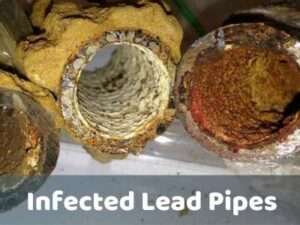
In the event that the lead concentration in the water exceeds the prescribed standard of 15 ppm, the system should make sure that the public is properly informed of the necessary steps and actions that should be taken to mitigate any potential health risks.
To ensure the continued protection of public health, it is recommended that contaminated lead pipes under the control of the water system be replaced, thereby safeguarding the public from lead exposure.
It is worth noting that the EPA’s generally accepted action safe level for lead in water is 15 parts per billion (ppb).
Signs of Lead in Tap Water
According to the Environmental Protection Agency’s findings, a significant portion of our daily exposure to lead comes from contaminated water sources, amounting to approximately 10% to 20% of our overall exposure.
The primary contributor to lead contamination in drinking water is outdated and corroded piping systems, including faucets and pipes. This phenomenon is caused by the gradual deterioration of plumbing infrastructure, which leads to the release of lead particles into the water supply.
Additionally, low mineral content or acidic water left to stagnate in pipes for extended periods can also contribute to the problem.
Lead Exposure Risks
Here are steps to assess whether you are at risk.
- You can start by calling your local municipal water supplier and inquire about levels of leads contaminants.
- Majority of public water supplies upload yearly reports online, you can reach them by typing your zip code into the Environmental Protection Agency website at www.epa.gov/cc.
Your local lead levels should be below the EPA’s action level of 15 parts per billion.
Recommended Post:- Best Water Filter For Lead
Health Effects of Lead in Drinking Water
Lead exposure is a significant threat to human health, as it hinders the proper functioning of various body systems, leading to nervous system disorders, heart diseases, brain damage, and renal failure.
Pregnant women and children are particularly susceptible to the harmful effects of lead exposure through drinking water.

It is noteworthy that a large number of houses constructed in the 1990s in the United States are still supplied with lead service pipes, which can contaminate the water with lead.
It is crucial to remain mindful of the long-term and short-term health consequences of lead poisoning and take appropriate measures to prevent exposure to lead.
Best Water Filter for Lead Removal
A recent and straightforward approach to eliminate lead from tap water is by utilizing a water filter. However, before using this method, it is crucial to identify the source of contamination and the extent of the problem.
Various filtration methods are available for removing lead from water, and the following are among the most effective and cost-efficient:
Reverse osmosis is deemed the most efficient technique for removing lead from drinking water, with a removal rate of up to 99.9%.
Distillation, while it removes 99.9% of impurities and provides pure water, has the drawback of being sluggish and energy-intensive.
Activated carbon filtration is another effective method that can eliminate up to 99% of lead. The primary disadvantage of this method is that the filters tend to clog and lose their efficacy over time.
1. Home Master Under-sink RO Water Filter System (TMAFC-ERP)
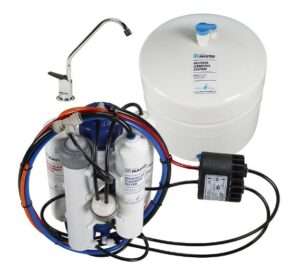
The Home Masters TMAFC-ERP reverse osmosis system is a top-notch water filtration solution renowned for its advanced filtration technology, particularly in the elimination of lead from drinking water.
This system boasts a seven-stage filtration process that guarantees the production of high-purity water by eliminating up to 99.9% of chemicals, such as chlorine, chloramine, and other impurities that may compromise the water’s safety.
In addition, this system comes equipped with a built-in permeate pump that minimizes water wastage, saving you money over time by lowering your water bills. Furthermore, its filter-changing mechanism is straightforward and lasts for a year or up to 2000 gallons.
While the price of this system may be on the higher end of the spectrum, its benefits far outweigh its cost, making it an excellent investment for anyone who values the safety and quality of their drinking water.
Click Here to View Full Customer Feedback & More on Amazon
2. ISpring High Capacity RO Drinking Water Filtration System (RCC7)
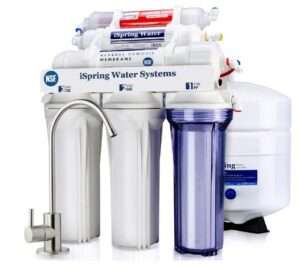
The under-sink installed high-capacity reverse osmosis filtration system is designed to provide a reliable solution for softening and purifying tap water. It effectively removes over 1,000 pollutants, including giardia, calcium, lead, salt, and viruses, with an impressive 99.9% efficiency rate.
This system stands out for its exceptional ability to reduce lead content by up to 99%. Additionally, it boasts low maintenance expenses and features a leak detector that alerts users whenever there is moisture accumulation beneath the filter system.
Notably, this unit is highly cost-effective, boasting a pure to wastewater ratio of 1:3. Every time you turn on the tap, you can expect a consistent supply of clean, pure, safe, and great-tasting water.
Click Here to View all Customer Feedback & More on Amazon
3. APEC RO-90 Ultra Safe RO Drinking Water Filter Water System
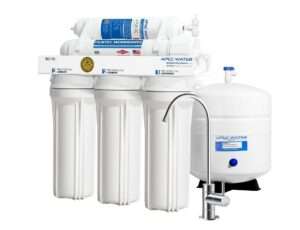
The Ultimate RO-90 filtration system is a high-capacity water filtration solution that guarantees the delivery of clean and safe drinking water at all times.
Designed and manufactured in the United States, the system is built to meet the most rigorous safety and quality standards, making it both durable and efficient in the reverse osmosis industry.
Through extensive testing and certification by the Water Quality Association (WQA), the APEC RO-90 has been proven to effectively remove over 1,000 contaminants commonly found in drinking water, including harmful substances such as chlorine, fluoride, lead, heavy metals, bacteria, and viruses.
With a 99% removal rate of these contaminants, the system ensures that your water is not only refreshing but also safe for consumption.
Investing in the Ultimate RO-90 filtration system guarantees you access to reliable, high-quality water, and the peace of mind that comes with knowing that your drinking water is free from harmful contaminants.
Click Here to View Most Customer Feedback & More on Amazon
The most common health effects of lead exposure from drinking water and other sources are listed below.
1. Prenatal Effects
Low amounts of lead exposure may have an effect on the mother and her fetus.
According to the American College of Obstetricians and Gynecologists (ACOG), “lead may readily pass the placenta to the fetus’s brain.”
These pregnant health risks may lead to gestational hypertension, miscarriage, preterm delivery, and low birth weight. It is strongly recommended that pregnant women avoid drinking water from lead pipes.
2. Pica
Pica is an unusual condition that makes people crave of items that are not meant to be edible like a paint chip, dust, chalk, hair, and hardened clay soil.
Children that show symptoms of lead poisoning tend to eat paint chips, dust, and chalkboard.
3. Lowered IQ in Children
Overexposure of lead through contaminated water, is known to produce a spectrum of damages across multiples body systems.

In young children, lead affect the growth and development, thereby causing Lowered IQ in Children’s brain, leading to a lower (IQ) intelligence quotient.
Also, Lead exposure can affect the behavior, intelligence, and attention life span of a child: note the World Health Organization.
4. A trigger of Autoimmune Diseases
The aforementioned conditions—multiple sclerosis, lupus, chronic fatigue syndrome, rheumatoid arthritis, type 1 diabetes, and fibromyalgia—have all been proven to be linked to a build-up of heavy metals, particularly lead.
Autoimmune illness develops when the immune system incorrectly identifies and attacks healthy cells.
5. Mood Swing Disorders
Lead exposure may negatively affect both adults’ and children’s mental health; adults may experience sadness and anxiety, while children can develop attention-deficit hyperactivity disorder (ADHD).
The behavior of children who display temper tantrums, lash out, and grow more aggressive is called behavioral dyscontrol.
6. Loss of Appetite
The increased amount of lead absorbed by youngsters as a result of overexposure may lead to an inability to eat properly and contribute to weight loss as well.
There are, however, numerous health issues linked to each of these diseases, therefore it is strongly recommended that you see your doctor first.
7. Death
Lead poisoning is deadly and affects children far more than adults. It may induce unconsciousness and convulsions in youngsters.
The behavioral problems and mental impairment that the children who survive lead poisoning may face may last for years to come.
What Causes Lead in Water

Because of human activities including fossil fuel burning, mining, and manufacturing, lead has recently increased in distribution.
The corrosion in our home plumbing system is the primary main source of lead in our homestead’s water.
Corrosion is a process in which water and metal come into contact and the water molecules react with the metal, thus destroying the pipe, fixtures, and faucets from the inside.
Other sources of lead exposure:
Soil: Lead particles that have settled on the ground from paint and leaded gasoline still exist for decades and even after they’ve settled, lead pollution is still a serious issue on the road and buildings constructed on tarmac.
The amount of lead included in ceramic glazers and porcelain may readily seep into food portions.
Dust in the air. Paint chips that usually fall off the wall may be mixed with dirt to make it more easier to inhale contaminated dust when sweeping the floor.
In these candies, lead is found in the component Tamarind.
China-made toys are often found to contain elevated levels of lead.
These occupations put people at a higher risk of lead exposure and carry it home on their clothing.
Lead Exposure Prevention
You can protect yourself and your family against lead poisoning with a few simple do-it-yourself projects.
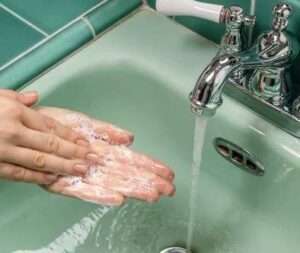
1. Whenever possible, use a wet mop or a moist cloth to wipe dusty surfaces and wall peelings.
2. Take off any shoes that have grease on them. This will help to keep lead pollutants from entering your home or office building.
When playing outside with children, wash hands and toys with soap to minimize the risk of contamination from hand to mouth transmission of contaminated dirt or dust.
4. If you reside in a home with an ancient plumbing system (lead pipes or fittings), it is recommended that you run cold water for a minute before using the toilet.
5. Always keep your home in good condition by inspecting it for issues and paint peelings. Never remove paint peeling with a knife or sand it with sandpaper since this may create dust that has a high concentration of lead.
How to Make Your Home Lead-Free

The following are important guidelines for maintaining a lead-free household.
1. Inspect the paint on a regular basis for signs of peeling, chipping, or deterioration.
Remove all of the loose paint from an area that has been peeled by wetting it first and then sanding it to remove any remaining paint.
2. Conduct a regular inspection of all painted surfaces such as windows, stairways, and doors for signs of paint degradation. If you see any loose paint, gently remove it with a wet paper towel.
3. Always clean smooth surfaces once a week to keep dust under control.
To protect yourself and your children against lead poisoning, follow these precautions.
4. Hot water has much higher concentrations of lead concentrates than cold water. When cooking or preparing infant formula, be sure to use cold water at all times.
5. Make sure you get enough iron, calcium, and zinc in your diet on a regular basis.
Drink plenty of water and eat plenty of green vegetables, peanut butter, red pepper, and oranges, since these foods assist to reduce lead absorption.

7. Always run water from the faucet for a minute or two to flush away corrosion before consuming it to avoid poisoning yourself.
8. Make use of existing filtration devices, such as a water pitcher, which are capable of filtering out 99 percent of lead and other heavy elements, such as mercury, from the water.
Make sure that your drinking water is tested for lead.
Is it possible for bottled water to contain traces of lead?
Bottled water is a product that is closely supervised and controlled by the United States Food and Drug Administration (FDA).
The permitted amount of lead in bottled water is 5 parts per billion (ppb), which is lower than the 15 parts per billion (ppb) approved by the Environmental Protection Agency.
Furthermore, the Food and Drug Administration bans bottled water companies from utilizing any food-contact materials such as pipes, pumps, tanks, fittings, bottling equipment, containers, and other similar items that may make or adulterate the bottled water unfit for human consumption.
Related Post